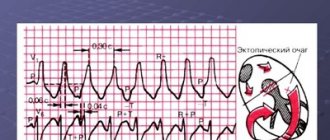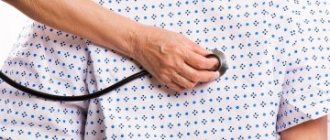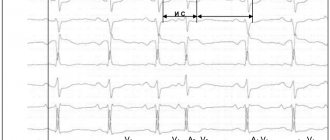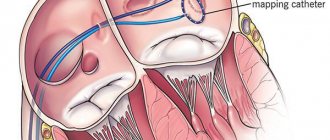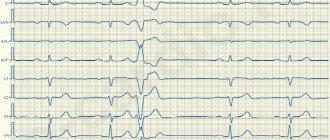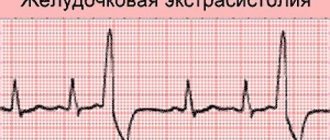Cardiologist
Sokolov
Denis Vladimirovich
16 years of experience
Cardiologist of the first category, candidate of medical sciences, member of the Asute Cardiovascular Care Association (ASSA)
Make an appointment
Extrasystole is a pathology manifested in the form of cardiac arrhythmia. Those suffering from this disease experience extrasystoles - extraordinary contractions of the heart or its individual parts. Patients may feel short of breath, anxiety, and cardiac arrest. The main diagnostic methods are ECG, Holter monitoring, stress cardio tests. The therapeutic course is aimed at eliminating the root cause of heart rhythm disturbances. Treatment of extrasystole is carried out under the supervision of a cardiologist.
General information
The pathology develops against the background of early depolarization of the atria, ventricles or atrioventricular junction. Due to these disorders, the patient's heart contracts prematurely. Isolated cases of extrasystoles can occur in healthy people of any age group.
Most often, signs of extrasystole are detected in men and women over 50 years of age. The disease causes a decrease in coronary and cerebral blood flow. With a complicated course of the pathology, patients may experience cerebrovascular accidents and atrial fibrillation.
Reasons for the development of pathology
The functional form of the disease, which develops in healthy patients without obvious causes, is considered by cardiologists as idiopathic. Heart rhythm disturbances can result from the use of:
- strong tea;
- coffee beans;
- strong alcohol;
- narcotic substances.
Similarly, the condition of patients can be affected by osteochondrosis of the cervical spine, neuroses, vegetative dystonia and arrhythmia (in trained athletes). Women may experience single extrasystoles due to premenstrual syndrome.
The reasons for the development of an organic form of extrasystole in a patient may be:
- heart attacks, cardiosclerosis, coronary heart disease;
- pericarditis and myocarditis;
- congenital or acquired heart defects;
- sarcoidosis, amyloidosis, hemochromatosis.
In some cases, heart rhythm disorder is provoked by an imbalance of sodium, potassium, magnesium and calcium ions in myocardial cells.
Types of pathology
The most common classification of the disease takes into account the reasons for the development of extrasystole in patients. Doctors distinguish functional, organic and toxic forms of pathology. An alternative typology is based on the localization of ectopic foci of excitation and allows us to distinguish four types of heart rhythm disturbances:
- ventricular (62% of clinically diagnosed cases);
- atrioventricular (2%);
- atrial (10%);
- sinoatrial (0.2%).
An important diagnostic sign is the frequency of extrasystoles in the patient. Seizures occurring no more than 5 times per minute are considered rare. The average frequency is recorded at 6–15 extrasystoles per minute, high - at 16 or more.
The problem is not in the extrasystoles themselves, but in the attitude towards them
of extrasystole during the day . Of course, this scared him. The main thing here is to understand that if a person does not have organic damage to the heart muscle, but has neurosis or some kind of exhaustion, then the problem is not in extrasystoles. Because there are people who have 30 thousand extrasystoles a day, but they don’t feel them and live normally. Moreover, almost all people have extrasystoles; they can be detected using a holder - an electrocardiogram device that reads information throughout the day. So the problem is not in the extrasystole , but in the attitude towards it.
Symptoms
Symptoms of extrasystole are not always clearly expressed - the organic form of the disease can proceed almost unnoticed. Extrasystoles are most difficult to tolerate by persons suffering from vegetative-vascular dystonia.
During attacks, patients feel tremors inside the chest, interruptions and freezing of the heart. With functional extrasystole, pain appears, accompanied by fever, weakness, increased sweating, lack of air and increasing feelings of anxiety.
Systematic extrasystoles reduce cardiac output, which leads to a decrease in coronary, cerebral and renal circulation. Patients may feel dizzy. Doctors often record fainting, aphasia or paresis in men and women of the older age group.
And here is what antiarrhythmologist Alexander Ivanovich Korzun says about extrasystole:
“ extrasystole and does not require treatment. To their misfortune, someone feels these extrasystoles. In such cases, it is optimal to distract yourself with life: friends, family, children, work, hobbies, etc. If you can’t get distracted, then you need the help of a psychotherapist.”
According to these experienced doctors, it turns out that it does not matter what kind of extrasystoles a person has: ventricular, supraventricular, or preventricular. It is important that if he does not have organic heart disease, then the problem of extrasystole can be successfully solved with the help of a psychotherapist. There are also good experts who say: before there was no holder, and all people lived peacefully. Now the problem arises due to the fact that a person begins to feel extrasystoles, and the holder records them, thus creating a problem. Psychotherapy helps here, that is, increasing stress resistance.
True, the same Korzun also says that extrasystole is often a consequence of problems of the gastrointestinal tract. And gastrointestinal diseases primarily occur in people suffering from nervous disorders. Therefore, if a person really has problems with the gastrointestinal tract (gastritis, ulcers, reflux esophagitis), then he really needs to first treat the stomach in order to reduce the severity and manifestations of extrasystoles.
About drugs
Often, if a person goes to a cardiologist, he is prescribed antiarrhythmic drugs: Citalex, Propanorm, etc. Here, everyone takes responsibility for themselves whether they will take these medications or not, but reliable sources say that these drugs worsen a person’s condition. Therefore, you just need to keep in mind that with a healthy heart, extrasystole does not cause any problems. Problems begin when a person begins to obsess over them, when he begins to struggle with them, when he begins to read what he does not need to read and interpret it incorrectly.
With all the trust and respect for Eduard Guglin or Alexander Korzun, by constantly visiting their sites, a person only harms himself because he comes across some messages that he does not need. He begins to read about other types of arrhythmia, about other problems, without understanding the connection between them and taking individual phrases out of context.
Simply because an ordinary person who has problems and is looking for solutions to them is not a qualified cardiologist.
Therefore, if a person has such a symptom of vegetative-vascular dystonia as extrasystole , and he really wants to get rid of this problem, then, first of all, it is necessary to exclude communication on this topic, stop visiting medical sites and begin to move along the path of getting rid of neurosis, from anxiety disorder, from your internal tension, which leads to these problems. And then the extrasystole will gradually go away.
Of course, this article is intended for a rather narrow audience: some have extrasystole , others do not. If you don't have one, you're lucky: you don't even have to think that you might have one. But if it does appear, you are doubly lucky, because you will know that this is a completely harmless form of arrhythmia.
Diagnostic measures
Diagnosis of extrasystole takes place in two stages. During the first, the cardiologist examines the patient and collects objective data for anamnesis. The second stage involves men and women undergoing cardiac tests.
Confirmation of the preliminary diagnosis is carried out during ECG and 24-hour Holter monitoring. These methods make it possible to detect extrasystole in the absence of obvious symptoms of pathology in the patient. Heart rhythm disturbances that do not manifest themselves at rest are recorded during a treadmill test and bicycle ergometry. Ultrasound and MRI of the heart are used as additional diagnostic methods.
Treatment
The treatment tactics for extrasystole are determined by a cardiologist, taking into account the form of the disease diagnosed in a man or woman. The development of heart rhythm disturbances against the background of pathologies of the digestive or endocrine systems will require the patient to contact a gastroenterologist or endocrinologist.
Neurogenic types of the disease are treated with sedatives. If the pathology is toxic, the cardiologist cancels or reduces the dose of drugs that lead to heart rhythm disturbances.
Drug therapy is based on antiarrhythmic drugs. The duration of the course ranges from 4 to 8 weeks. The daily dose of drugs received by the patient gradually decreases as the frequency of extrasystoles decreases.
Radiofrequency ablation is performed when the effectiveness of drug therapy is low. Electrodes are inserted into the patient's heart cavity (through punctures in the femoral vein or artery). Radiofrequency pulses affect arrhythmogenic zones and normalize their condition.
What cardiologists write about extrasystole
Cardiologist Eduard Romanovich Guglin:
“ Extrasystole is the most common and most harmless form of heart rhythm disturbance. Extrasystole is a manifestation of increased excitability of the heart muscle. Most often these are functional changes, but we do not find organic changes. And the heart, despite sometimes many years of extrasystole, remains healthy. This type of arrhythmia does not shorten life or increase the risk of other diseases or death. She's harmless enough. And the drugs that we use with greater or less success to suppress it, to reduce its frequency, are themselves quite toxic compounds.
As a result of large studies, it has been repeatedly established that suppressing extrasystole with antiarrhythmic drugs worsens, rather than improves, health, and therefore we usually try to persuade patients not to treat extrasystole. The whole problem is that in the normal state of the central nervous system they do not reach consciousness, do not rise above the subcortex and are not perceived by the brain. And with increased excitability, with various neuroses, these signals break through the barrier of the subcortical filter, and are perceived at the level of consciousness as something extra disturbing. With increased nervous sensitivity, they are perceived as a disorder, pathology, and frighten, alarm, and interfere with life.
Continuation
You just need to believe that extrasystole is not a harbinger of any organic heart disease, does not shorten life and, as a rule, does not require treatment. However, if it spoils life and reduces its quality, it can be treated with sedatives and sedatives. They increase the sensitivity threshold, transfer this reaction back to the subcortical level, reducing the degree of their perception by consciousness. They improve the tolerance of interruptions, making them less noticeable and less disturbing.
Let me give you an example: an athlete with ventricular extrasystoles who does not have organic heart disease has no risk of developing cardiovascular diseases. In one of the recent publications, ventricular extrasystoles of 2000 or more per day were determined in 70 athletes. They were suspended from physical activity for 3 months. In 16 of them, PVCs disappeared completely, in 34 PVCs decreased to 500 or less, in 20 there were no changes. All were allowed to compete, and over 8 years of observation, no one had any cardiovascular diseases.
Previously, it was assumed that high gradations of extrasystoles (class 3-5) were the most dangerous. However, further studies found that the clinical and prognostic significance of extrasystole (and parasystole) is almost entirely determined by the nature of the underlying disease, the degree of organic damage to the heart and the functional state of the myocardium. In persons without signs of myocardial damage, with normal contractile function of the left ventricle (ejection fraction), more than 50 extrasystoles , including unstable episodes of unstable ventricular tachycardia, even continuously reducing tachycardia, do not affect the prognosis and do not pose a threat to life.”
Prognosis and prevention
The nature of the prognosis formed by the cardiologist depends on the form of pathology diagnosed in the patient. The least favorable cases are heart rhythm disturbances that occur against the background of myocardial infarction, cardiomyopathy and myocarditis. Changes in myocardial tissue can provoke atrial fibrillation. The absence of organic heart lesions allows doctors to formulate a favorable prognosis for 85–90% of patients.
A set of preventive measures is aimed at preventing diseases that provoke heart rhythm disturbances: coronary heart disease, cardiomyopathies, myocarditis, etc. Patients of all age groups are recommended to regularly undergo preventive examinations in clinics, visit a therapist, cardiologist, neurologist and doctors of other specializations.
People at risk are advised to exercise moderately and avoid drinking drinks high in caffeine and ethanol.
Extrasystole: why you can’t trust information on the Internet regarding its symptoms
Often people who feel the symptoms of extrasystole make a serious mistake: instead of immediately contacting a specialist (cardiologist, psychologist, psychotherapist), they start looking for information on the Internet, trying to find out what extrasystole , what is happening to them and how dangerous it is. They browse a huge number of medical sites and forums, receiving a barrage of completely unnecessary and often completely harmful information - and thereby only worsen their condition. So reading medical articles, communicating on forums and communities more often do harm than good. Why?
Firstly, the symptoms of extrasystole are discussed by unknown people, citing unreliable sources, many of which were either written by amateurs or are long outdated.
Secondly, websites and forums are often written by illiterate people who, although not on purpose, misinform readers.
Thirdly, people who really have heart problems come there: organic lesions, other forms of arrhythmia, etc. They communicate with people whose extrasystole is purely functional in nature, that is, it is just a psychological problem, and there are no pathological changes in the heart. As a result of such communication, a person with symptoms of extrasystole increases anxiety and fears of dying from heart disease, when in fact his heart is absolutely healthy.
Say no to forums and medical sites
Receiving a bunch of unnecessary and useless information, a person begins to limit himself physically, he develops a fear of extrasystole and develops cardiophobia. But if a person really wants to get rid of the fear of extrasystole , which is actually safe, he needs to avoid visiting any medical sites. Everyone. Even those where there are good cardiologists who confirm that extrasystole is, in principle, safe. It is enough to download a couple of articles where good cardiologists say that it is safe, and that’s all. And constantly visiting medical sites will lead to a person misinterpreting the information that is presented there, because he is not a cardiologist.
The same applies to forums dedicated to VSD. If you go to any of them and find a topic about extrasystole , you can read a lot of stories written by different people who are far from medicine. Moreover, all these stories are filled with complaints and do not contain any valuable information. Sometimes people on such forums write sheer nonsense, and a person, instead of finding ways to solve his problem, begins to get confused and scared.
